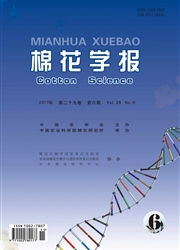

 中文摘要:
中文摘要:
以衣分差异较大的陆地棉品种为材料,构建了包含188个F2单株的作图群体,应用6111对SSR引物对亲本进行了分子标记筛选,结果仅获得了123个多态性位点,其中88个位点构建了总长为666.7cM、平均距离为7.57cM的遗传图谱,覆盖棉花基因组的14.9%。通过复合区间作图法对F2单株和F2:3家系进行QTL检测,共鉴定出了18个控制产量及产量构成因素变异的QTLs,包括2个衣分QTLs、4个子棉产量QTLs、4个皮棉产量QTLs、2个衣指QTLs、3个单株铃数QTLs、2个铃重QTLs和1个子指QTL。解释的表型变异分别为6.9%~16.9%、5.6%~16.2%、4.8%~15.6%、7.7%~13.3%、8.2%~11.6%、6.1%~7%和6.6%。不同QTLs在相同染色体区段上的成簇分布表明与产量性状相关的基因可能紧密连锁或一因多效。产量及产量构成因素QTLs的遗传方式主要以显性和超显性效应为主。检测到的主效QTLs可以用于棉花产量及产量构成因素的分子标记辅助选择。
 英文摘要:
英文摘要:
A genetic linkage map with 88 loci from 6111 pair SSR primers was constructed using 188 F2 plants obtained from a cross between two upland cotton cultivars, which differ remarkably in lint per- centage and have relatively high levels of DNA marker polymorphism. The map covered 666.7 cM with an average distance of 7.57 cM between two markers, or approximately 14.9% of the recombination length of the cotton genome. Composite interval mapping was used to identify the quantitative trait loci (QTL) in F2 and F2.a family lines. Eighteen QTLs for yield and its components were identified including two QTLs for lint percentage, four QTLs for seed yield, four QTLs for lint yield, two QTLs for lint index, three QTLs for bolls per plant, two QTLs for boll size, and one QTL for seed index. TheseQTLs separately explained 6.9%-16.9%, 5. 6%-16. 2%, 4.8%-15.6%, 7.7%-13.3%, 8.2%-11.6%, 6.1%-7%, and 6.6% of the phenotypic variance. Different QTLs affecting yield traits were detected within the same chromosome region, suggesting that genes controlling yield traits may be linked closely or the result of pleiotropy. The QTLs controlling yield and its components were mainly dominant and overdominant. The molecular markers linked closely to the major QTLs may be used in MAS (marker-assisted selection) to improve cotton yield and its components.
 同期刊论文项目
同期刊论文项目
 同项目期刊论文
同项目期刊论文
 期刊信息
期刊信息
